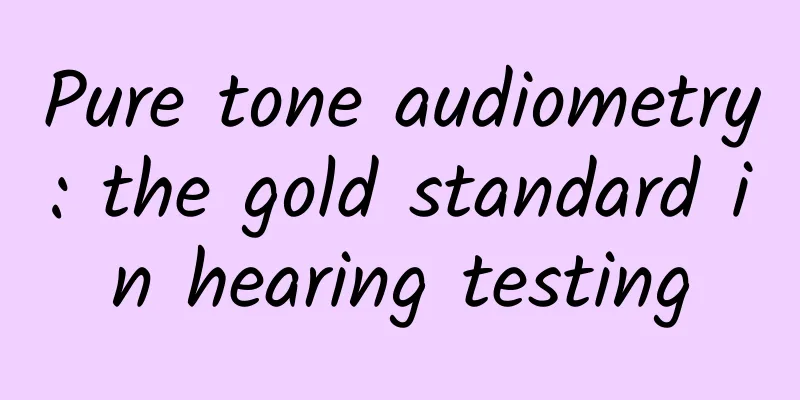Pure tone audiometry: the gold standard in hearing testing

|
When we go to the hospital and tell the doctor that we have hearing problems, the most common thing we hear the doctor say is "go get an audiometer done." So what is an audiometer? What is the purpose of an audiometer? Audiometry can be roughly divided into two categories: one is subjective audiometry and the other is objective audiometry. Subjective audiometry requires the cooperation of the patient. The patient hears the test sound and responds, and the tester makes a subjective judgment. The most common one is pure tone audiometry. Objective audiometry does not require the patient to make a subjective indication of whether or not he hears the sound signal. The test results are not affected by the patient's will or wishes, and no patient cooperation is required, such as the auditory brainstem response test. At first glance, objective audiometry seems to be more accurate than subjective audiometry, but it is not. Pure tone audiometry has irreplaceable advantages. It can quickly and accurately judge the patient's hearing level and ear lesions. It reflects the patient's hearing condition more intuitively, economically, and comprehensively. It was once hailed as the "gold standard." Why is it called the "gold standard"? Pure tone audiometry has been used as the preferred audiometric method since it was published by Professor Bunch in 1943. Pure tone audiometry is a standardized subjective behavioral response audiometry for testing hearing sensitivity, including pure tone air conduction threshold test and bone conduction threshold test. The hearing threshold refers to the minimum sound intensity that the subject can detect more than half of the stimulus signal given multiple times under specified conditions. In layman's terms, it is the minimum sound signal intensity that can be heard within different frequency ranges (generally 125Hz~8000Hz). Pure tone audiometry is still the most basic and most commonly used audiological testing method. Pure tone audiometry also has some limitations in some specific situations, such as disability assessment, forensic identification, etc. In order to more accurately reflect the patient's hearing condition, it is also necessary to combine objective audiometry for diagnosis. Pure tone audiometry requires patients to understand the test requirements and cooperate with the test, and also requires audiologists to accurately judge the hearing condition of each patient. Pure tone audiometry is easy to master, but it is not easy to get accurate results. It requires hearing professionals to accumulate experience and an absolutely objective attitude. Most pure tone audiometry tests for adults can be completed with cooperation. In order to obtain more accurate test results, it is very important for us to communicate with the patient and his/her family before the test. For example, sometimes the patient hears a sound signal that is highly similar to the tinnitus sound, and the patient cannot distinguish whether it is the tinnitus sound or the test sound, so the patient will keep sending us the signal "I heard it"; some patients do not understand the test requirements, and only have behavioral responses when they hear the sound signal intensity is relatively comfortable; some patients cannot communicate in language or text, which leads to incorrect or impossible hearing judgments. Therefore, before the test, we must first understand some basic information from the patient or family and communicate well. It is also very important to observe the ear canal before the test. For example, there is a lot of amniotic fluid in the ear canal of a newborn, the ear canal of the elderly is collapsed, there is otitis media perforation, cerumen embolism, cholesteatoma, etc. These situations will affect the hearing test results and need to be dealt with before the test. In short, in order to make the results more accurate, these details before the test need to be paid attention to, which can achieve twice the result with half the effort. Children cannot cooperate with hearing tests like adults, so we need to use some methods and techniques to complete the test, such as behavioral audiometry, which is to give children a sound stimulus and observe their behavioral response. Before the test, it is important to establish a "rewarding conditioned reflex" with the child and observe the child's preferences and psychological state. Sometimes the threshold at a frequency point must be repeated many times before it can be completed and done well, and finally a relatively accurate hearing chart for the child can be obtained. Why is testing so troublesome? "Early detection, early diagnosis, and early intervention" are the treatment principles for hearing impairment. Before the age of 5 is a critical period for hearing-impaired children to learn language, but objective audiometry has certain limitations. No response at 100 decibels in the auditory brainstem response test is the standard for most deaf children to get cochlear implants, but is there really no hearing between 100 decibels and 120 decibels? At this time, behavioral audiometry provides hearing-impaired children with more references to choose from. Whether it is wearing hearing aids, undergoing cochlear implants, language rehabilitation training, or ear surgery, accurate pure tone audiograms can help doctors, adjusters, and rehabilitation therapists get twice the result with half the effort, and hearing tests are the most basic. How is hearing impairment classified? A pure tone audiometry test will produce a pure tone audiogram, which provides a basis for diagnosis and treatment. The audiogram will clearly mark the hearing thresholds (-10dBHL~120dBHL) of low frequency (125Hz~500Hz), medium frequency (500Hz~2000Hz), and high frequency (2000Hz~8000Hz), and draw a continuous curve, bone wire and air wire, with the bone wire on the top and the air wire on the bottom. We generally inform the patient of his hearing condition according to the standard average of the sound intensity of the four frequencies of 500Hz, 1000Hz, 2000Hz, and 4000Hz, which is also called average hearing loss. There are two types of hearing loss, which are classified according to the degree and type of hearing loss. According to the degree of hearing loss, based on the hearing loss in one ear, it is divided into five levels: mild (26dBHL~40dBHL), moderate (41dBHL~55dBHL), moderately severe (56dBHL~70dBHL), severe (71dBHL~90dBHL), and extremely severe (91dBHL and above). Generally, less than 25dBHL is considered normal hearing. People with mild hearing impairment can decide whether to use hearing aids for intervention according to their wishes; people with moderate, moderately severe, and severe hearing impairments need intervention, and hearing aids can generally meet the needs of most people; people with extremely severe hearing impairments can consider high-power hearing aids or cochlear implants. The function of cochlear implants and normal cochlear sensory sound transmission is very different, and pure tone audiometry is needed to provide us with valuable hearing intervention suggestions. It is not enough to give intervention recommendations for all hearing-impaired people based on the degree of hearing loss, so it is also necessary to classify according to the type of hearing loss: based on the relationship between air and bone conduction, it is divided into conductive hearing loss, sensorineural hearing loss, and mixed hearing loss. Conductive hearing loss: The air-bone conduction difference is greater than 10 decibels and the bone conduction is within the normal range, which is commonly caused by the middle ear or outer ear. Sensorineural hearing loss: The air-bone conduction difference is less than 10 decibels and outside the normal range, most of which are caused by the inner ear. The air-bone conduction difference is greater than 10 decibels and the bone conduction is outside the normal range, which means that there are both conduction and sensorineural reasons. Patients with conductive hearing loss and mixed hearing loss must be diagnosed and treated by a physician before implementing hearing intervention measures. Through pure tone audiometry, combined with these two different classifications of hearing loss, we can preliminarily determine the patient's lesion location, degree and type of hearing loss, and determine whether hearing intervention is needed, etc. Let hearing impairment no longer be an obstacle to us! |
<<: Focus on comprehensive nutrition for children and lead their healthy growth
>>: Office workers: How many days of leave do I need to take to undergo myopia surgery?
Recommend
What are the customs for a baby's first month? Should the baby's head be shaved when the baby is first month old?
The baby's full moon means that the baby has ...
What color of latex paint looks good in the bedroom? The difference between scratch paint and latex paint
What color of latex paint looks good in the bedro...
What causes nipple pain during development?
Breasts are women's reproductive organs and o...
Adverse reactions to non-emergency contraceptive pills
Nowadays, women do not want to get pregnant and d...
Can pregnant women use toothpaste?
In recent years, many people like to have their t...
How to recover after giving birth?
It is difficult for a mother to be pregnant for t...
How long does it usually take for early pregnancy symptoms to appear?
Pregnancy is a happy thing for the whole family, ...
Detailed explanation of the five major manifestations of women’s mental infidelity!
When it comes to cheating, most people probably h...
Why do breasts swell?
In life, some women feel that their breasts are s...
What's up with pink vaginal discharge?
Would you be surprised when pink vaginal discharg...
A new definition of healthy eating? A diet that is good for both you and the planet, but too expensive
How can we eat to keep ourselves healthy while pr...
Treatment of left lower abdominal pain in women
I believe that many of our female friends have ex...
How to treat vulvar itching and peeling
If the vulva is itchy or even peeling, women need...
Is it a boy or a girl if morning sickness is severe?
If the baby has severe morning sickness, is it a ...
What causes vaginal epidermis itching?
Vaginal epidermal itching is vulvar itching, whic...









